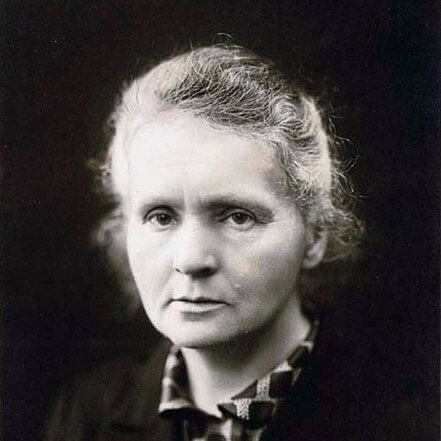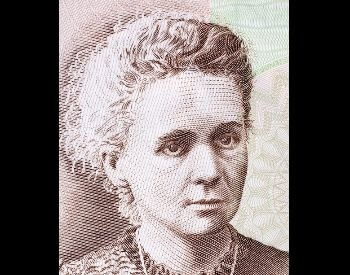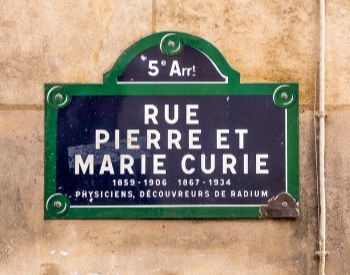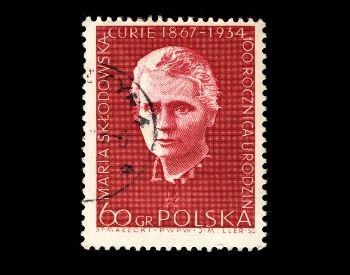
- Name: Marie Curie (Maria Salomea Skłodowska)
- Profession: Chemist and Physicist
- Born: November 7th, 1867 in Warsaw, Congress Poland, Russian Empire
- Died: July 4th, 1934 in Passy, Haute-Savoie, France
- Resting Place: The Panthéon in Paris, France
- Legacy: Famous for her work on radioactivity
25 Marie Curie Facts for Kids
- Marie Curie was a Polish chemist and physicist.
- Marie Curie is most famous for her work on radioactivity and radioactive elements.
- Marie Curie was born on November 7th, 1867 in Warsaw, Congress Poland, Russian Empire.
- Marie Curie was the daughter of Bronisława Skłodowski and Władysław Skłodowski.
- Marie Curie was the youngest of the four children by Bronisława and Władysław Skłodowski.
- Marie Curie married Pierre Curie on July 26th, 1895 in Sceaux, Hauts-de-Seine, France.
- Marie and Pierre Curie had two children, both girls. Their names were Irène Joliot-Curie and Eve Curie.
- Marie Curie died of aplastic anemia at the age of 66 on July 4th, 1934 in Passy, Haute-Savoie, France. Historians believe she her death was a result of her exposure to radiation during her work.
- In September 1897, Curie gave birth to her first daughter Irene Joliot-Curie. Later in life, Irene would win the Nobel Prize for Chemistry in 1935.
- In July 1898, both Curie and her husband discovered the chemical element polonium (Po).
- In December 1898, both Curie and her husband discovered the chemical element radium (Ra).
- In 1903, Curie won the Nobel Prize for Physics. She was the first woman to win a Nobel Prize.
- In 1903, Curie and her husband received the Davy Medal from the Royal Society of London. They received the metal for their work and research on radium.
- In 1903, Curie and her husband received the Matteucci Medal from the Italian Society of Sciences.
- In December 1904, Curie gave birth to her second daughter Eve Curie.
- In 1906, Curie’s husband Pierre Curie was killed in horse-drawn vehicle accident.
- In 1906, Curie became the first woman professor at the University of Paris.
- In 1909, Curie was awarded the Elliot Cresson Medal from the Franklin Institute for the discovery of radium.
- In 1909, Curie founded the Institute Curie in Paris France.
- In 1910, Curie was awarded the Albert Medal from the Royal Society of Arts for the discovery of radium.
- In 1910, Curie was successful in isolating radium in its pure metal form.
- In 1911, Curie won the Nobel Prize for Chemistry. This is her second Nobel Prize, and made her the only woman to win two Nobel Prizes. This also made her the only person to win two Nobel Prizes in different scientific fields.
- Between 1914 and 1918, Curie played an important role during World War 1. She served as the director of the Red Cross Radiology Service. She was instrumental in bringing X-ray equipment to help wounded troops. Her mobile radiography units were referred top as Little Curies (petites Curies).
- In 1930, Curie was elected to serve on the International Atomic Weights Committee.
- In 1995, both Marie and Pierre Curie’s remains are relocated to France’s national mausoleum, the Pantheon.
Pictures of Marie Curie

A picture of Marie Curieo on Polish currency.

A picture of a street named after Marie Curie.

A picture of a stamp with Marie Curie’s picture on it.
Additional Resources on Marie Curie
- About Marie Curie – Find more information on Marie Curie on the Live Science website.
- Biography of Marie Curie – Read the biography of Marie Curie on the Biography website.
- Timeline of Marie Curie – View a timeline of the life of Marie Curie on the Time Toast website.
- Marie Curie – Britannica – Discover more facts and information about Marie Curie on the Britannica website.
